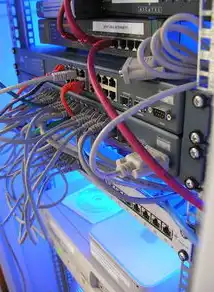本文目录导读:
HTTP 500 Internal Server Error is one of the most frustrating errors that web developers and users can encounter. This error indicates a problem on the server side, preventing it from fulfilling the request made by the client. While this error message itself doesn't provide specific details about what went wrong, there are several common causes and troubleshooting steps you can follow to identify and resolve the issue.

图片来源于网络,如有侵权联系删除
Causes of HTTP 500 Internal Server Errors:
- Application Code Errors: Bugs or syntax errors in the code running on the server can cause an internal server error.
- Resource Limitations: The server might be running out of memory, processing power, or other resources required for handling requests.
- Database Connectivity Issues: Problems with database connections can lead to internal server errors if the application relies heavily on database operations.
- Configuration File Errors: Incorrectly configured settings in configuration files such as
php.ini,nginx.conf, orhttpd.confcan result in server errors. - Plugin/Module Conflicts: In applications like WordPress, conflicts between plugins or modules can cause server-side issues.
- Server Overload: High traffic or excessive load on the server can sometimes trigger an internal server error due to resource exhaustion.
- Security Measures: Security measures like firewalls or intrusion detection systems might block certain requests, leading to server errors.
Troubleshooting Steps:
-
Check Server Logs:
- Most servers maintain logs that contain detailed information about errors. Review these logs for any relevant messages that could point towards the source of the problem.
- For Apache servers, check the error log located at
/var/log/apache2/error.log. - For Nginx servers, look at
/var/log/nginx/error.log.
-
Review Application Code:
- Look for any obvious syntax errors or bugs in your application's codebase.
- Use debugging tools or IDEs to step through the code and identify where the error occurs.
- If using frameworks like Laravel or Symfony, ensure all dependencies are correctly installed and up-to-date.
-
Check Resource Usage:
- Monitor server performance metrics such as CPU usage, memory usage, and disk space.
- Tools like
top,htop, or monitoring services like New Relic can help track resource utilization. - Consider scaling up hardware resources if necessary to handle increased demand.
-
Examine Database Connections:
- Verify that your application has proper database connection configurations.
- Check for any timeouts or connection failures reported in the server logs.
- Ensure that the database server is running smoothly without any errors.
-
Inspect Configuration Files:
- Double-check all configuration files for typos or incorrect settings.
- Pay special attention to directives related to file uploads, maximum execution time, and memory limits.
- Update outdated configuration files to match current best practices.
-
Test with Minimal Configuration:
- Try to replicate the error in a minimal environment with only essential components enabled.
- This helps isolate whether the issue lies within the core application logic or external factors like plugins or themes.
-
Consult Documentation and Forums:

图片来源于网络,如有侵权联系删除
- Refer to official documentation for guidance on troubleshooting specific server setups (e.g., PHP, Node.js).
- Online forums and communities often have threads discussing similar problems encountered by others.
-
Implement Proper Error Handling:
- Develop robust error-handling mechanisms within your application to catch exceptions gracefully and provide meaningful feedback to users.
- Avoid displaying sensitive system information directly to end-users which could expose security vulnerabilities.
-
Use Monitoring Tools:
- Set up real-time monitoring solutions to detect anomalies early and respond quickly before they escalate into major issues.
- Services like UptimeRobotics or Datadog offer comprehensive insights into server health and performance.
-
Seek Professional Assistance:
If you've exhausted all possible DIY methods and still cannot pinpoint the root cause, consider reaching out to professional support teams or hiring experienced developers who specialize in resolving complex server-side issues.
In conclusion, while HTTP 500 Internal Server Errors can be challenging to diagnose and fix, following systematic troubleshooting steps and leveraging various diagnostic tools will increase your chances of identifying and resolving the underlying problem efficiently. Remember that proactive monitoring and regular maintenance are crucial in maintaining smooth operation across web applications and ensuring user satisfaction.
标签: #http 500内部服务器错误



评论列表